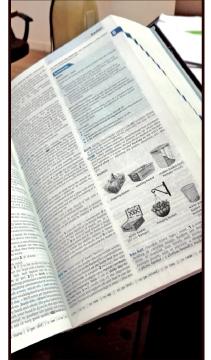
Lord Macaulay (1800-1859), the celebrated British historian, essayist and statesman was asked what ten books he would take if he were shipwrecked on a desert island. He said he would take a dictionary for sure to understand the other nine books.
Like Macaulay, you probably would take the dictionary for granted as a necessary part of your life. However, some of us may not know that the English language was in use for a very long time before the words were put into a dictionary in a systematic way. The word ‘dictionary’ came into being only in 1526, less than 40 years before the birth of William Shakespeare. In the United States, the first dictionary was published in 1604, three years before the founding of Jamestown, the first permanent English settlement in America.
Nathan Bailey
The need for a dictionary was felt as many languages such as Hebrew, Greek, and Latin were growing rapidly at the time. There were also many authors using English creatively. The first English dictionary was compiled by Robert Cawdrey who was an English schoolmaster. It included only about 2,500 difficult words at a time when the English vocabulary was limited to about 100,000 words. Cawdrey named four languages from which English words had been borrowed. They were Hebrew, Arabic, Greek, and Latin. His dictionary was followed by The New World of English Words compiled by Edward Phillips who was a nephew of John Milton, the well-known author of Paradise Lost. The dictionary included 11,000 words.
Edward Phillip’s dictionary was followed by a number of other dictionaries. Nathan Bailey, a London schoolmaster compiled three extensive dictionaries between 1720 and 1740. As in modern dictionaries, he included word origins, definitions, a key to pronunciation and apt illustrations. His dictionaries had a ready market in the 18th century.
Two volumes
The 18th century saw order and proportion in all human activities. City streets had geometrical and symmetrical designs. Order and proportions overflowed to language and literature. It was during that period, that Alexander Pope and Thomas Gray wrote poetry using metrical patterns. Dr. Samuel Johnson (1709-1784) compiled his famous A Dictionary of the English Language. His dictionary was full of definitions and comments. In his preface to the dictionary he said, the English Language was in a state of confusion and it could be reduced to an orderly system. Johnson drew illustrations from the great writers of the Elizabethan period.
Johnson’s dictionary was popular in Colonial America which later became the United States. Noah Webster wrote an abridgement to Johnson’s dictionary. Webster, a Yale University graduate, practised as a lawyer and then became a teacher. He was not happy with the spelling and grammar used in textbooks. In 1828 he published An American Dictionary of the English Language. It was published at a time when the United States was emerging as a nation. Webster gave new meanings to words. He cited English authors, but added quotations from American writers such as, Franklin, Washington and Adams.
Today, Webster Comprehensive Dictionary (International Edition) is available in two volumes. It is backed by three quarters of a century of experience in dictionary-making and is designed to serve the needs of those who speak or use the English language.
In the 19h century scholars introduced a new approach to language based on the inductive analysis of information. As a result, the need for a more comprehensive dictionary of the English language was felt. Hundreds of scholars got together to produce the Oxford English Dictionary (OED) which contained more than half a million words, their etymologies, phonetic representations, definitions and quotations.
The OED has become an established and authoritative work for all English scholars and learners. Many of our libraries do not possess the complete set (12 volumes) and a supplement. Most private and public libraries have access to the Shorter Oxford Dictionary or Oxford Advanced Learner’s Dictionary. In addition, there is a Pocket Oxford Dictionary.
Important single tool
Any aspiring writer should have access to more than one dictionary. Although OED is the standard reference book, there are other equally useful dictionaries. For instance, as a student I used the Chamber’s Dictionary. Today, it has expanded into Chamber’s 2-in-1 Dictionary and Thesaurus. It contains more than 30, 000 entries and 70, 000 definitions. The Longman Dictionary of Contemporary English is meant for advanced learners. It contains 230, 000 words, phrases and meanings plus 165, 000 corpus-based examples.
Young people the world over know that English is the most important single tool they need to achieve success in their careers. If you are thorough with the exact meaning of words, you will not make blunders in communication. Recently, I overheard a person telling the other, “Rex has a photogenic memory.” “Photogenic” means “always looking attractive in photographs.” He should have said “photographic” which means “able to remember exactly every detail of something you have seen.” On another occasion I overheard a conversation between two teachers. One teacher told the other, “Young people don’t want to become teachers because there is no glory in the teaching profession. “Glory” means “the importance, honour and praise that people give someone they admire a lot.” He should have said, “There is no glamour in the teaching profession.”
Any writer or journalist who does not want to become a laughing stock should have access to a reputed English dictionary.
It can be a printed book or a digital version. If possible, carry a dictionary wherever you go. Constant reference to a good dictionary will help you to use the right word in the right place. I have a queer feeling that dictionaries have a seductive power over their users.
